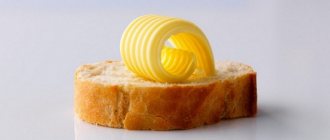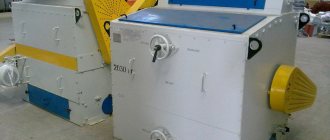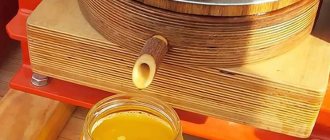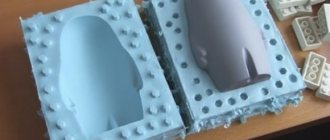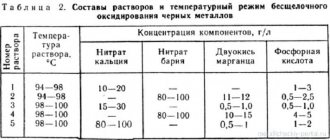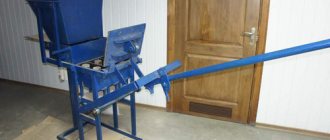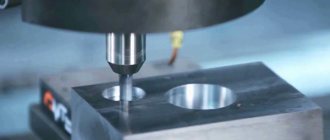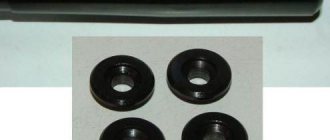Retail chains offer us the familiar well-known product, sunflower oil, in a fairly wide range. The oil offered varies in grade, type, quality, price, production and processing methods. Not everyone, however, is confident in the quality of the industrially produced goods offered, since manufacturers often use some unhealthy substances in the process, the remains of which may be in the final product. Some manufacturers also add dyes and stabilizers (you don’t want this kind of oil at all, much less cook with it for children).
But there is a way out (for those who are diligent).
You can prepare high-quality cold-pressed sunflower seeds at home; the basic recipe is simple. So you need to find high-quality seeds of varieties suitable for processing. For those who are going to constantly make sunflower oil at home, it makes sense to purchase or make-order some devices. Beginners can get by with more familiar or homemade primitive kitchen devices.
How to make sunflower oil?
We'll tell you how to squeeze and store sunflower oil at home.
The general principle for obtaining homemade sunflower oil is as follows: the seed must be peeled, squeezed out the oil, filtered and/or cleaned in another way.
In serious home production, calibrators (seed cleaning devices), oil presses and various filters are used to clean seeds.
To obtain sunflower oil in small quantities, the seeds can be cleaned with a seed mill and processed in a grinder (or using a blender, food processor, or meat grinder). Then pour the mixture of seeds and husks with cold water so that the unnecessary husks float up (this process is called hydroflotation). After removing the husks, throw the mixture of seeds and water onto a sieve and let the water drain.
In another option, if you can thoroughly peel the grains from the husks before squeezing, then after squeezing the grain mass will turn into a cake, to which you can add sugar syrup or honey - you will get an excellent halva. Hydroflotation is not necessary in this type of process.
Do not use ready-made peeled seeds - the oil will taste bitter.
Now squeeze out the oil. By the way, there are attachments for meat grinders for separating juices from pulp, which are very suitable for our purposes. Or you can make your own press from a small aluminum pan. Drill several holes along the bottom of the pan closer to the center to drain the oil. In the center of the bottom we drill a hole for a long thick bolt and secure it firmly (with a nut). We use a wooden circle with a hole for a bolt as a piston. Think about further improvements yourself. Screw a nut on top of the mug.
Place the mass from which we will press the oil into a press and tighten the nut with a convenient wrench, taking your time. As the oil drains, we tighten it a little more... and a little more, and until it stops. Of course, under the press there is a container into which the oil flows.
Now the oil can be filtered. It’s even better to first freeze the oil in a powerful freezer at a temperature no higher than – 15°C, and then filter it, this way we will also remove any remaining water.
It is best to store oil in dark beer bottles filled to the top, sealed tightly, away from light, in a cool place.
To process oilseeds, special equipment is used - an oil press. By using such a simple device, which some craftsmen make with their own hands, at home or in small-scale production, you can obtain an environmentally friendly product that is superior in taste and healthiness to oils sold in stores. The technical characteristics and design of the equipment used depend on which plant crops and in what quantities the oil must be obtained.
To obtain oil for your needs, it is enough to acquire a device whose design is quite simple
Design Features
Producing vegetable oil at home using a purchased or self-made press has a number of features that must be taken into account.
- When producing oil at home, the finished product has a two-year shelf life. A home press can be purchased in a serial version or made by yourself.
- Using a household squeeze press, you can extract oil from sunflower seeds, olives and even nuts.
- One of the simplest and most cost-effective ways to make a device for extracting oil is to remake a serial household press designed for squeezing juice from grapes and apples. In such equipment there is no need to change working attachments - it is enough to replace the holder with a device of higher power. This modernization will allow the unit to be used not only for processing olives, but also for squeezing oil from sunflower seeds.
- A home oil press, the basis of which is a worm screw responsible for pressing, can be made using improvised means. When designing such a press, keep in mind that the pressure it will be able to develop will depend on both the diameter of the worm nut and the power of the beam risers. To provide the created device with higher reliability, the beam that serves as the basis of its structure should be made more powerful. These requirements are fully met by a wooden oil press, the mechanism elements of which are made of solid oak. A budget alternative to such a unit is a press, the structural elements of which are made of metal.
- A household press (like any other) used for squeezing oil requires a cylinder without a bottom in its design, which can be used as an ordinary metal barrel. To increase the rigidity of such a cylinder in its lower part, you can take a metal hoop. If a wooden barrel is used as a cylinder, the material from which it is made must be dry and highly hard. The ideal material in this case would be solid oak.
- Important design elements that an oil press should be equipped with include the peeling rollers, which are a pair of replaceable rollers. Their rotation is ensured by gears mounted on the metal racks of the device. On the racks, in addition to the gears, the upper and lower buckets are fixed, as well as a handle, which ensures the rotation of the mechanism elements, or a toggle bucket. Peeling rollers are usually made of wood, and their working surface is lined with a float cloth.
To make peeled sunflower seeds soft, you need to lightly fry them, or simply heat them on a hot surface so that the oil from the sunflower kernels comes to the surface a little. This will make it easier to squeeze out the sunflower oil. But roasted peeled seeds for extracting oil are softer and more pliable.
What can be prepared from peeled sunflower cake? Usually, bait for fishing is made from macaques. Among fishermen, a good makha is highly valued. If mixed with other feed, steamed macadamia is given to poultry and livestock.
In a similar way, using a homemade oil press, you can obtain pumpkin oil from pumpkin seeds at home.
All this is learned empirically; no one will give you specific recommendations. Using two rollers, you can easily peel the seeds from the husks. Then, in windy weather, remove the husks on an open surface. If there is no wind, you can use a simple fan. Sunflower seeds can be pre-roasted before peeling or after, it depends on the type of seeds. Then the oil is pressed out using any press. The press can be either mechanical or hydraulic. The mechanical method is less expensive but more labor-intensive. However, in a village where interruptions in the electrical network and other pleasures of life are not uncommon. Let's try to make a lever press. The owner of his good-quality farm can install a homemade press for squeezing vegetable oil at home. Pressing sunflower oil at home is the simplest thing, all you need is strength and dexterity.
For this we need a rectangular frame. Can be made from rolled metal. As an alternative, thick oak timber. A thick-walled rectangular metal container with a thick metal plate and a lid exactly the size of the container. You need to drill thin holes in the container to drain the squeezed oil. Next is a large diameter worm screw with a nut. The larger the diameter, the greater the pressure power. A steel circle or thick rod must be welded to the sides of the nut. Now pour the toasted seeds into a container and place it in a rectangular frame. Cover the top with a steel plate. insert the screw with the nut and squeeze until oil appears. Here's a simple oil press. low cost. Of course, the output will not be the same oil as at the oil mill. But still, why not try. The main thing here is well-roasted seeds and press pressure. The stronger you are, the more oil you will squeeze out. The process is not easy, but it is the simplest since ancient times. But the oil can also be squeezed out using rollers. Two rollers are rotated by an electric motor using gears. The distance between the rollers should be minimal so that the sunflower grains do not slip between them. The method is simpler but the device is more expensive, you need good bearings, you need to make rollers, you need to find out how and where to connect the electric motor. In this way, you can squeeze oil from flax seeds, hemp seeds, pumpkin seeds, watermelon seeds, and melons. As well as oil from various kinds of nuts. The easiest way to obtain oil from pine nuts is at home, since the kernels are the softest. Why can't I make oil from pumpkin seeds? Or rather, oil is obtained, but there is very little of it. If the seeds are not from a new harvest and are not of an oily variety, then you will be able to get very little oil. Good pumpkin oil only comes from good pumpkin seeds. In general, a lot depends on the pumpkin variety. For example, you can’t cook pumpkin porridge from every pumpkin either. So, not every pumpkin seed will produce oil. If it is not possible to squeeze sunflower oil yourself at home, the question arises: How to calculate sunflower oil? So that there is no deception. If you brought several bags of sunflower seeds to the churn, how many liters of sunflower oil should you be given, and how many liters of sunflower oil? Here is a table below with oil output to help you.
Approximate oil yield Pine nut oil 60% Pumpkin seed oil 30% Almond nut oil 50% Walnut oil 70% Sesame seed oil 45% Sunflower kernel oil 50%
The time has come to knock down the oil, but how not to be deceived at the churn? How many seeds do you need per liter of oil? How much oil does a bag of seeds yield? It depends on how you squeeze out the oil. Roasted seeds will contain more oil than raw ones. Then a lot depends on the quality of the seeds. If seeds are fried in a butter churn, then a kilogram of seeds will yield 0.4 liters of oil. Raw sunflower seeds will yield 0.2 liters of oil. On average, one bag of sunflower seeds will hold about 35 kilograms of seeds. Here is simple arithmetic: if a bag of sunflower seeds is fried in a butter churn, then one bag of sunflower oil will yield approximately 14 liters of oil. Or just a good bucket. If you simply beat the oil from raw sunflower seeds, you will get about 7 liters of oil from a bag of seeds.
After you have pressed the sunflower seeds at home and obtained the oil, all that remains is to clean it. How to purify sunflower oil at home. After you have pressed the sunflower oil, the question arises: how to filter sunflower oil at home? It's quite simple.
Extra virgin sunflower oil, the healthiest and most natural. But it has impurities and will need to be purified. For these purposes, no special devices are required. Leave the freshly squeezed oil in the bowl and let it settle. Then use a simple filter, such as gauze, to strain it. You can filter it using a simple device. Place a loose cloth in a funnel and pour the settled oil through such a “filter”. Pack the finished oil in glass jars or bottles, close the lid, and store in a dark, dry, cool place.
As a recommendation, when squeezing oil, do not use metal, or especially galvanized, utensils. Let it be aluminum cookware, stainless steel cookware, or glass.
Operating principle
Once the wooden oil press (or metal) is assembled and equipped with replaceable attachments, you can begin to use it for its intended purpose. To extract oil using such a unit (for example, from sunflower seeds), you must perform the following steps:
- Raw materials are poured into the loading ladle of the device.
- The rollers, the surface of which is covered with a grater cloth, are driven into rotation by means of a handle.
- Due to the rotation of the rolls, the raw material is drawn into the gap between them, where the peeling occurs.
- After peeling, the sunflower kernels and the husk from which they are freed end up in the lower bucket.
- The mixture consisting of sunflower kernels and husks is winnowed.
- Rollers with a grater cloth are replaced with rollers with a smooth surface, with the help of which vegetable oil will be squeezed out.
- The cleaned seed kernels are placed in the upper bucket and sent to rolling.
- To reduce the size of the gap between the rollers, which is necessary so that the seed kernels passing between them are compressed with the required force, a special lever of the hand press, which is moved to the second position, allows.
- The result of rolling is a mushy mass, which must be pressed to extract the vegetable oil from it.
Manual type wooden hydraulic oil press for squeezing oil from seeds and nuts
Since a manual squeezing press is not able to provide the high pressure exerted on the raw materials used, the percentage of oil yield is lower than when using specialized equipment. If you use an electric motor or a hydraulic press to drive such equipment, you can correct this shortcoming.
A manual oil press has a number of advantages. We present the most significant of them.
- Due to the simplicity of the design, such a press can be made by hand.
- The finished product has excellent taste and high nutritional value.
Manual screw press for home oil extraction
At home or in a small production workshop, you can use both a wooden and a screw press to produce vegetable oil, which are highly efficient. It should be kept in mind: if you do not make such devices for extracting oil yourself, but purchase ready-made models, then a wooden press based on a hydraulic mechanism will cost much more than a screw press. If you take such a unit to organize a small business producing and selling environmentally friendly vegetable oil, it will pay for itself quickly enough. Such equipment will pay for itself even faster if you use it to produce not only sunflower, but also olive or even cedar oil.
Homemade oil press
To obtain oil industrially, the seeds are filled with gasoline fractions.
Hexane, for example. When oil is formed from the seeds, this hexane is removed using steam, and its remains are removed with alkali. At the exit, various undesirable substances appear in the finished product: resins and pigments. Residual solvents are rarely completely evaporated. Before the oil obtained by extraction can be consumed as food or used in medicine, it needs to go through several more stages of purification: refining, then hydration, then bleaching, then deodorization and finally a couple more filtration steps.
We've heard the phrase about oils that go through 7 stages of purification. It's true! Extraction oil can be endlessly refined, filtered, refined, filtered - to get rid of traces of chemical gasoline components.
What is the result?
A product without the slightest signs of life: without a single color and with a complete absence of any odor. The resulting liquid is bottled, and “oil” is proudly written on all labels, misleading all buyers as if it is so.
It is interesting that in Russian supermarkets, for example, more of this refined oil is sold per year than the amount of all the seeds grown in Russia and the CIS!
How is this possible? With the help of cheap palm oil, which is used to dilute already deodorized, refined and processed oils in all possible chemical ways.
Now it’s clear why vegetable oil is HARMFUL?
Because it is impossible, even with the longest and highest quality processing, to remove residues of chemicals and gasoline from it - they will definitely be present in the finished product. In addition, refined oil, which has been subjected to heat treatment and exposure to chemicals, unlike natural oil, has a very low content of vitamins, proteins, phosphatides, chlorophyll and carotene. Its composition is saturated with fats and is very different from what nature originally “intended.”
And then we eat it! We fry food in oil and gasoline! But few people know that at high temperatures, chemical reactions occur in it, as a result of which new, extremely toxic compounds are formed. Therefore, under no circumstances should the oil be heated above 150 degrees or reused! And in a frying pan it reaches a temperature of as much as 250 degrees.
Throughout our lives, without thinking at all, we consume this super-toxic miracle in food, and even with gasoline, and then we are surprised by our unexpected illnesses and poor health. We are outraged that people get cancer at an early age and age faster than before...
What to do?
But you need to make your own oil press, fortunately there is nothing complicated here.
The mini oil press ensures the production of high-quality oil that lasts for 1-2 years. It can be used to obtain oil from sunflower, rice, hemp, flax, pumpkin seeds, watermelon, melon, and nuts.
Once upon a time, hardware stores sold mechanical presses for pressing grape or apple juice, some of them providing pressure of up to 12 atmospheres. Adapting them to oil pressure is very simple: you just need to replace the holder with a more powerful one.
If you were unable to purchase such a press, then it can be made from scrap materials. The design provides pressure on the mass using a worm screw. The pressure force depends on the power of the beam risers, as well as the diameter of the worm nut. Therefore, it is better to make a beam with a large power reserve, that is, thickness and width, from hard wood, or find a metal one.
The design has a cylinder without a bottom. It can be made anew or made from part of a barrel, preferably a new one with straight riveting, reinforced at the bottom with another hoop. The press wheel is made of hard wood: oak, beech, ash, acacia. The material must be dry. It is advisable to make all other wooden parts of the structure from the same material. If you use metal (pallet, hoops, flange), then it is advisable to use stainless metal or bronze.
At oil pressing plants, the operations of peeling the husk and crushing the kernel are performed separately. Here they were able to be combined in one design, which is not difficult to manufacture.
Skinning rollers are two replaceable rollers that rotate using gears mounted on metal risers, to which the upper and lower buckets, changeover lever or rotation handle are also attached. All these parts can be made or picked up from scrap metal. Replaceable wooden rollers, linen-lined graters (depending on the width, one or two graters are needed per roller, on which they grind potatoes into starch or potato pancakes).
The installation process occurs as follows: when the seeds poured into the bucket are peeled from the husks, gear 2 rotates from working gear 3, and from them the upper roller, lined with a grater cloth, rotates. Attached to operating gear 3 using a lever and a spring, changeover gear 1 engages with it and rotates another roller (lower), covered with a grater cloth. The direction of its movement is rotational. The seeds that are fed into the gap between the rollers are peeled off. The kernel and husk fall into the lower bucket.
This mixture is collected, winnowed and, replacing the rollers with smooth ones, poured back into the upper ladle. Now for rolling. But in order for the structure to crush the mass, the lever must be moved to position B in order to disengage gear 1, which will now rotate freely in the same direction as gear 2, squeezing and pressing the core. The rolled mass in the form of a slurry is used for pressing and squeezing out the oil.
Both the peeling rollers and the press separately work incomparably. The product comes out clean, of high quality, and tasty, especially when the kernel is well fried. To do this, frankly speaking, you need experience (all this is achieved experimentally). Product yield is slightly lower than at specialized enterprises. This is understandable, the pressure is not the same. But this, as they say, is not so bad.
Insufficiently squeezed out pulp (cake), if the kernel has been well cleaned, can be successfully used for making candies, cookies and other sweets.
And the oil comes out of high quality. In addition, it is possible to mechanize these installations and install electric motors. Make several different types of installations and open a home oil refining mini-factory, etc.
Did you like the article? Subscribe to the channel to stay up to date with the most interesting materials
What methods are used to extract oil from vegetable raw materials?
Vegetable oils, depending on the extraction method, are divided into two main types, each of which involves the use of a specific technology and appropriate equipment. These types, in particular, are:
- oils obtained by hot pressing;
- cold pressed oils.
Oil extraction area using double hot pressing
If the oil is produced using hot-pressing technology, then the pulp obtained after rolling is placed in special fryers, where it is heated to a temperature of 110° and at the same time moistened. At the same time, the mass is constantly stirred. After such preparation, the raw materials are placed in a screw device, where pressing is performed, as a result of which the oil is released. Vegetable oil obtained using hot-pressing technology is distinguished not only by its beautiful dark golden color, but also by a very bright aroma, as well as the taste of fried seeds.
Meanwhile, cold-pressed vegetable oil is considered more useful, since the raw materials for its production are not subjected to thermal effects, and accordingly, the product retains all its beneficial properties. For cold pressing of oil, a technology similar to that described above is used, only it does not include the stage of heating the pulpy mass that has passed through the rollers. Vegetable oil obtained using cold-pressing technology, although it has more beneficial qualities, has a shorter shelf life, and over time acquires a darker color and a bitter taste.
Personal experience in squeezing sunflower oil using a manual oil press
To obtain oil from seeds at home, we bought a stainless steel oil press - Dream manual RAWMID ODM-02, for 9,500 rubles.
We would like to share our experience. We tried to use this oil press to squeeze sunflower seeds grown in central Russia.
Structurally, the oil press resembles a meat grinder, with the difference that its body is much smaller in diameter, more elongated, and the screw is correspondingly longer. The auger ends not with knives, as in a meat grinder, but with nothing, and the pressed mass is fed to a conical nut (let’s call it a shank), which is screwed onto the body of the oil press. The auger rests on this shank and, thanks to its conical shape, the seeds are crushed and pressed.
Installation of a manual oil press into the working position is carried out by connecting the mounting bracket, which is attached to the body of the oil press with three bolts and wing nuts.
The structure is pressed to the table with two bolts from below; under each bolt a round metal foot 5 mm thick with a recess for the screw is placed. The use of spacers for screws made of a thinner iron strip is unacceptable, since when tightening the bolts, the spacer moves and is pressed at an angle.
As our experience has shown, the optimal thickness of the table board is 40 mm, and the height of the table from the floor is one meter. If you make the table lower, your neck muscles will become tense during work; if you make it higher, it will be awkward to twist.
Further assembly is not difficult; you need to insert the auger after placing a brass ring on the axle. The ring must be lubricated with sunflower oil for initial lubrication, then assemble and put on the handle, and place a funnel for filling the seeds. Then screw the shank, but you don’t need to tighten it too much. A plug is screwed into the outlet hole of the shank, which will need to be unscrewed at the beginning of work, when operating pressure is created.
The oil press kit includes an alcohol lamp, which is installed in a special place and is designed to heat the body of the oil press in a place closer to the shank. As fuel, you must use only food grade or medical ethyl alcohol with a strength of at least 80°. The use of other flammable substances is prohibited for hygienic and fire hazard reasons.
The alcohol lamp needs to be filled with alcohol about 1/3 and the wick should be generously moistened along the entire length, including the place where it burns; this place should be pulled out by 5 mm. Then set it on fire and place the alcohol lamp in a special place, securing it with an elastic band.
Work should begin when the alcohol lamp warms up the body a little; this will take 2-3 minutes. A cup for collecting oil is installed next to the alcohol lamp under the body of the oil press. Now you can pour the seeds into the funnel and start twisting. You don’t need to add a lot, about a handful, it’s better to add more often.
Start turning the handle.
After 7–10 revolutions, the working pressure will build up, then you need to unscrew and remove the plug from the outlet hole of the shank and continue to rotate the handle. In this case, the pulp should begin to come out of the outlet hole. Then you need to make 5 turns in the opposite direction. Then the mode of operation is as follows: 1) adding seeds (so that they are always in the inlet); 2) 11–15 revolutions forward; 3) 5 turns back, during which the oil, pleasing to the eye, flows into the glass in a cheerful stream. If you do not rotate backwards, then more oil will escape with the cake.
According to our observations, the optimal temperature of the body when heated with an alcohol lamp is achieved when, when rotating with force, vibration in the form of a characteristic creaking disappears and there is a barely noticeable smell of heated seeds, and perhaps a slight crackling sound when you stop the rotation. If the smell becomes too noticeable, it smells like roasted seeds and the crackling becomes stronger, the alcohol lamp should be extinguished for a short time.
To light a spirit lamp without removing it, it is better to get a turbo lighter.
A break in work should not be taken for more than 2 minutes, since the cake in the shank area quickly hardens without movement.
It's not as hard to twist as it might seem at first. After some time, it is easy to achieve a stable rhythm, working according to the indicated scheme, making approximately 2 revolutions every 3 seconds, working continuously for 1.5–2 hours.
When completing the work, you need to extinguish the alcohol lamp, immediately unscrew the shank with pliers, use a pointed tool, such as a screwdriver, clean it as much as possible from the cake, at least in the center, and put it in a bowl with hot water. After a few hours of soaking, it is easy to remove the pulp. If this is not done immediately, then cleaning the shank from the pulp will be a very lengthy and unpleasant procedure.
The oil yield in our case was approximately 50 ml from a one-liter mug of seeds (400 g of seeds). This takes an average of 17 minutes.
The oil turns out black, since we used the seeds without peeling. After about a day of settling, the blackness settles and the oil acquires a noble golden color and becomes transparent. Very tasty and aromatic!
The oil obtained in this way, without overheating, contains many useful substances and microelements, but unlike refined oil, it cannot be stored for a long time and becomes cloudy over time. Under the influence of high temperatures and light, vitamin A and other beneficial substances are destroyed in it, and oxides are formed. Therefore, it is important not to overheat the body of the oil press during spinning, but to extend the shelf life, store the oil in a dark place at a temperature of +5 to +15, in dark bottles filled with a cork so that there is no contact with air.
Production equipment
Even high-performance equipment designed for producing vegetable oil in industrial conditions is small in size and, accordingly, does not require much space for installation. Modern models are often mini-complexes for the production of vegetable oil, equipped with various working modules, which significantly expands their functionality.
Screw oil press, designed for cold continuous extraction as part of a production line or as an independent device
Thus, a typical sunflower oil production line operates according to the following principle.
- The raw materials must be dried, cleaned of various contaminants, and foreign impurities are removed from them.
- In a special module, the seed kernels are separated from the husks and crushed.
- The crushed seed kernels are steamed, and if we are talking about hot pressing, they are also fried.
- The oil is squeezed out from the prepared mass.
- The oil obtained immediately after pressing goes through a filtration stage, which significantly increases its purity.
- After filtration, the finished oil is poured into containers and sent for storage.
Hot oil extraction line (click to enlarge)
In addition, modern lines for the production of vegetable oil from seeds necessarily contain modules where the finished product is refined and deodorized, which improves its quality characteristics.
And finally, a video with a presentation of a professional screw oil press used in serious production.
A business idea for the production of sunflower oil is based on an oil mill. From an investment perspective among professionals, the idea has not lost its popularity and is still in demand and profitable.
However, for many, the issue of income in this area is quite controversial, which is in vain. Let's take a closer look so as not to rely on the opinions of the majority, but to base our own conclusions on specific numbers and facts.
In this business you won’t be satisfied with just butter. The profit from its sale is hardly enough to reach the cost level. But we must not forget about the additional products obtained from the creamery, which bring a significant net profit.
Equipment for the production of vegetable oil
The production of vegetable oil at home is limited by financial resources. This type of business is attractive for its flexibility of rapid development. You can start with a minimum set of production workshops, and then expand with additional equipment for the production of by-products. Thus, the range expands, and profits grow progressively. A full-fledged plant for the production of vegetable oil must be WASTE-FREE!
The minimum configuration of the line consists of the following equipment:
- Mini oil press. The power of such an oil press is 2 kW. per hour, 220 V. Capacity = 13 liters per hour. Press weight 45 kg. The average cost is $800.
Food filter. The oil must be cleaned using a special filter with a capacity of 0.5 m2. at one o'clock. Productivity = 5 liters per hour. Filter weight 100 kg. Cost 1100-1300 dollars.
By and large, these two components are already quite enough to produce and sell two products: good sunflower oil and meal. By the way, meal from oilseeds is widely used to feed animals and birds in agriculture. Therefore, it sells much faster than the main product. In addition, there is much more of it at the output of processed raw materials - 65%.
But if you plan to earn more, then you should think about expanding production. Additional technological equipment for the production of vegetable oils allows us to obtain several products from one oil mill at once:
- Sunflower oil, raw.
- Fried sunflower oil.
- Technical drying oil.
- Circles of the crown.
- Shrot.
- Biochar from fuz.
- Biofuel briquettes made from husks.
A creamery, even at home, can produce 7 types of products if the necessary equipment is available. It is worth paying attention to other advantages of business.
Storing vegetable oil in production does not require special conditions. A dry room, protected from sunlight, with an air temperature ranging from +5 to +15 degrees, can store unrefined products for 5 months.
You can use different raw materials to produce vegetable oils. For example, seeds: sunflower, soybean, flax, pumpkin and many other oilseeds. This advantage also has a positive effect on expanding the range and increasing sales. You can repurpose your business for other products without upgrading the line.
Sana Juicer 707 in practice. Part 4 – Cold pressed oil at home
Where to begin
Cold pressed oil can now be obtained at home at any time convenient for you. All you need is quality seeds of your choice and a good juicer (Sana 707 in our review) with an oil press. This means a special attachment that is installed on a horizontal juicer, with the help of which it is easy and simple to prepare flaxseed, sesame, poppy, nut, grain and many other oils.
But it is important to remember: homemade oil is natural, so to maintain quality it should be kept in a dark, cool place for no more than 14 days.
How to prepare flaxseed oil
Flax is a well-known oilseed crop. There are several types of it, in particular long-lasting and curly. To extract oil at home, it is better to take the latter. It produces up to 50% of the output oil.
The cooking process is very simple, you just need to follow a few points:
- you need to add the seeds a little at first, and only when the first drops of oil appear at the exit can you add more;
- To obtain the required pressure inside the press chamber, you should use seeds with a moisture content of no more than 15%, that is, dried (but not overdried).
From 500 g of flax you should get about 200 ml of oil.
For flaxseed oil it is better to use flax flax
Cold pressed sesame oil
Since sesame is brought from India, you need to pay attention to its quality. Depending on this, from sesame seeds can be obtained from 15 to 45 percent of oil. Seeds must be fresh, oilseed varieties. Please note that sesame oil can be different: with a lot of pulp if it is white polished sesame, and transparent if it is black sesame.
Technology for the production of vegetable oils by pressing
Production flow diagram:
The technological line for the production of vegetable oil is equipped with:
- Separator for coarse and fine cleaning of grain and seeds.
- Hulling machine for sunflower seeds and other oilseeds.
- Twin-screw oil press extruder with heating elements for mint up to +50C (for a quick start).
- Filter for purifying vegetable oils from fuses (food grade).
- Press for squeezing fuses (fusodka).
- Press for forming crown circles.
- Press for briquetting sunflower husks and other seeds.
- Auxiliary equipment, structures and devices: bunker; pneumatic loader; weight; buckets, shovels, etc.
Vegetable oil production waste and its use
A homemade butter churn for sunflower oil production pays for itself faster if all its advantages are rationally used. Don't underestimate the importance of waste management.
At the exit from the oil press we obtain vegetable oil that is unrefined and black in color. It should either be settled or filtered from the fuses in a special way.
Fuzz is small particles of husk and dust with a large content of residues of the produced product, which remains after filtration. The best method for removing waste is considered to be a fabric filter. You should not spare money on the filter, and then it will efficiently clean the product and prepare it for presentation. When the oil is cleared, the collected fuses can be pressed on a fusodushka. From it we can still get 20% bio-coal + 80% vegetable oil. The processed fuses are further turned into stone, which in turn is used as fuel for boilers.
Don't skip the fusodach operation, as careless businessmen do! After all, some companies buy waste from vegetable oil production enterprises very cheaply in order to then squeeze out all the profit from them.
Thus, a business idea can become an almost waste-free process. You will receive not only a high-quality product that will not be in demand at any time of the year, but also unique fuel and good corn.
Creamery profitability
So, the raw materials for production (sunflower seeds) cost about 500 dollars (about 480), if we talk about a ton. After the raw materials are processed, approximately 350 kg of sunflower oil can be obtained from this amount (yield 35%). One liter can easily be sold for one and a half dollars. Thus, for 350 kg the total cost will be $525. 525 – 480 = $45 profit. Of course, $45 per ton is a small amount. But do not forget that during production, you can also earn money on another product - on makukha (meal).
Macukha, by the way, is no less a popular commodity than butter itself. Upon receipt of 350 kg of the main product, the meal will be 650 kg. Most often, meal is bought in whole bags, and not by the kilogram, so it will sell much faster. Makukha is sold out at $0.4 per 1 kg. So, if you multiply 650 kg. by $0.4, the amount will be $260. Considering these numbers, the business idea becomes much more interesting.
- Author: Maria Sukhorukikh
Rate this article:
- 5
- 4
- 3
- 2
- 1
(0 votes, average: 0 out of 5)
Share with your friends!
